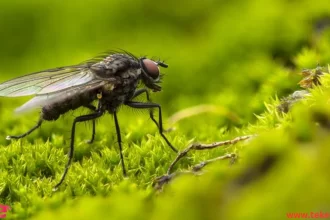The Nano Leaf Chameleon Insect is considered one of the smallest reptiles in the world, with over 11,000 species of reptiles, and its length does not exceed 29 mm.
Let’s learn more about it from teketrek.
Facts about The Nano Leaf Chameleon Insect
Discovered in Madagascar in the rainforests, specifically in the northern part of the island, the Nano Leaf Chameleon is known to be a ground-dwelling species rather than arboreal, and iit endangered due to deforestation in Madagascar.
The genus of Nano Leaf Chameleons consists of 30 species, all of which inhabit the island of Madagascar, with most being ground-dwelling species that spend the majority of their time on the ground.
This type of reptile, specifically the Nano Leaf Chameleon, is found in grass
The miniature males may need larger hemi penis to enable better mechanical compatibility with female reproductive organs during mating.
The Nano Leaf Chameleon possesses many distinctive features, and due to its small size, it is important to explore its key details further.
The Nano Leaf Chameleon is extremely tiny, small enough to comfortably sit on the tip of a finger.
The pair discovered by scientists are the only known samples of this species ever found by humans.
Continuous deforestation in northern Madagascar threatens the survival of the Nano Leaf Chameleon.
Climate change may be a future cause, but currently, it is deforestation.
As a small chameleon, the Nano Leaf Chameleon can extend its tongue twice the length of its body to catch prey.
During the day, Nano Leaf Chameleons can be found in the leaf litter of the dry karst forests on Nosy Hara, a small island off the coast of Madagascar. Here, they hunt for prey, blending into their surroundings for both camouflage and hunting.
At night, Nano Leaf Chameleons climb trees up to about four inches high.
When disturbed, they can mimic a dead leaf, vibrate, or leave their spot and drop to escape heat, bad weather, or predation.
They may also hide in one of the many crevices.
Nano Leaf Chameleons adapt well to their habitat, to the point that any serious disturbance could endanger the species.

The Nano Leaf Chameleon specification
The Tongue: possesses a projectile tongue used to capture prey.
The Size: The Nano Leaf Chameleon is small enough to sit on an aspirin tablet. Male Nano Leaf Chameleons are much smaller than females.
Eyes, penis: It has attractive rotating eyes and large hemi-penis.
The color: The Nano Leaf Chameleon has a light gray color on the head, back, and tail, with the tail turning orange and then yellow towards the tip.
The body sides are brownish with occasional dark brown spots, and the extremities are entirely dark brown.
The head: Adult Nano Leaf Chameleons have a flat head with large triangular scales forming plates above their eyes.
The back: There are two rows of granular projections along their backs.
The Foot: Each foot of the Nano Leaf Chameleon has five toes, with the toes grouping in pairs or trios, each with a claw to aid in climbing.
https://teketrek.net/how-do-animals-build-their-homes-in-winter/
Where can Nano Leaf Chameleons be found
Nano Leaf Chameleons are found in Nosy Hara, an island largely made of karst, a type of limestone called tsingy in the native language.
They are also found in Madagascar’s coastal and humid rainforests, where abundant food is available.
What is the diet of Nano Leaf Chameleons
Nano Leaf Chameleons are carnivorous, feeding on small invertebrates like fruit flies, ants, and whiteflies.
They also feed on birds, other chameleons, and frogs.
https://teketrek.net/the-long-legged-hawk/
Reproduction stages of Nano Leaf Chameleons
Scientists know a lot about mating habits of Nano Leaf Chameleons but expect internal fertilization.
After mating, a female Nano Leaf Chameleon digs a hole and lays at least one egg, no more than two.
The egg size is large compared to the female’s size, and after laying the egg, she covers it and leaves it to fate.
The egg hatches after about three months, and the young become independent.
Nano Leaf Chameleons can live up to ten years, but scientists still do not know how long they live in the wild.

FAQs about Nano Leaf Chameleons:
What threats do Nano Leaf Chameleons face?
Nano Leaf Chameleons are not toxic to other animals, and their small size makes them vulnerable to larger predators like larger chameleons like Parson’s chameleon is the size of a cat, frogs, birds like Madagascar cuckoo, and any small mammals sharing their island.
They are close to being threatened because trees are still being poached on the islan.
What are some interesting facts about Brookesia micra?
Cool Facts:
Brookesia micra is currently the tiniest chameleon in the world. A baby Brookesia micra is so small that it can perch on the tip of a person’s fingernail. Interestingly, the tails of Brookesia micra have only 20 vertebrae, compared to the usual 50 found in larger chameleon species.
Why is the nano-chameleon so small?
The extreme miniaturization observed in B. nana and other tiny Brookesia chameleon species may be attributed to their ability to efficiently utilize the limited resources available to them at such a small size.
Can nano-chameleon change color?
Yes, chameleons change their colors by controlling the distance between nanocrystals on their skin.
How big is a nano-chameleon?
It is about 21.6 mm (about 0.9 inches) long.
Do nano chameleons lay eggs?
The female “nano-chameleon” is larger than the male to make room for the eggs it lays, the researchers suggested.
In conclusion, it is important to highlight the significance of this reptile species and emphasize the need for protected areas and significant efforts to protect them from threats and extinction.
References:
Wikipedia





